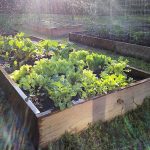Learn how to grow chamomile with this plant profile of an herb renowned for its soothing tea.
Botanical Name: Matricaria chamomilla (common chamomile) or Chamaemelum nobile (Roman chamomile)
Light Requirements: Chamomile prefers full sun to partial shade. It thrives in bright sunlight, but it can tolerate some shade, especially in hotter climates.
Water Requirements: Chamomile prefers moderate moisture levels. It’s important not to overwater, as it can lead to root rot. Water the plant when the top inch of soil feels dry, typically every 1-2 weeks, depending on environmental conditions.
Soil Requirements: Chamomile grows best in well-draining, sandy or loamy soil with a slightly acidic to neutral pH (around 6.0 to 7.0). It doesn’t tolerate heavy clay soil well. Good drainage is essential to prevent waterlogging, which can cause root rot.
Fertilizer: Chamomile is not a heavy feeder and usually doesn’t require much fertilizer. A light application of balanced fertilizer (such as 10-10-10) in the spring can help promote healthy growth. Alternatively, you can amend the soil with compost or well-rotted manure before planting to provide nutrients.
Hardiness Zones: Chamomile is typically hardy in USDA zones 3-9, depending on the species. Roman chamomile (Chamaemelum nobile) is more cold-hardy and can tolerate colder temperatures than common chamomile (Matricaria chamomilla).
How to Grow Chamomile
Chamomile can be grown from seeds or transplants. It self-seeds readily, so if you let it go to seed, it may come back in subsequent years without needing to replant. Regular pruning or harvesting of chamomile flowers can help encourage bushier growth and prolong the flowering period.
The herb is known for its fragrant, daisy-like flowers and delicate, feathery foliage. It’s commonly used for herbal teas, as well as in culinary and medicinal applications. It attracts beneficial insects such as bees and butterflies to the garden.
It’s important to keep an eye out for pests like aphids, spider mites, and caterpillars, which can sometimes be attracted to chamomile plants. These pests can usually be managed through cultural controls or organic pest control methods.
What Is the Difference Between Roman and German Chamomile?
Roman chamomile (Chamaemelum nobile) and German chamomile (Matricaria chamomilla), commonly known as English chamomile and common chamomile respectively, are two distinct species within the Asteraceae family frequently confused due to their resembling appearance and shared applications. Roman chamomile, a perennial plant, spreads low to the ground, forming dense mats of foliage typically reaching heights of 6 to 12 inches (15 to 30 cm), while
German chamomile, an annual counterpart, grows upright with a bushier habit, often attaining heights of up to 2 feet (60 cm). Roman chamomile emits a slightly sweeter aroma reminiscent of apples, contrasting with the stronger, more pungent scent of German chamomile.
Flower-wise, both exhibit daisy-like blooms, but Roman chamomile flowers boast white petals surrounding a yellow center, while German chamomile flowers feature similarly styled petals but tend to be larger with a prominent yellow center. Roman chamomile spreads via creeping stems and can become invasive if not contained, commonly utilized as ground cover or in paving gaps, whereas German chamomile, an annual plant, readily self-seeds, facilitating easy cultivation in gardens or containers, although it necessitates replanting each year.
Despite their differences, both species are prized for their aromatic flowers, frequently employed in teas and herbal remedies.
How to Grow Chamomile for Tea
Choose the Right Variety
When growing chamomile for tea, it’s essential to select the appropriate variety. Opt for German chamomile (Matricaria chamomilla), as it’s the most commonly used type for making chamomile tea due to its aromatic and flavorful flowers. German chamomile seeds or seedlings are readily available at garden centers or online nurseries.
Select a Suitable Location
Chamomile thrives in locations with ample sunlight. Choose a spot in your garden or on your balcony that receives at least 6 hours of sunlight daily. However, chamomile can also tolerate partial shade, especially in hotter climates. Ensuring proper sunlight exposure will promote healthy growth and abundant flower production.
Prepare the Soil
Chamomile prefers well-draining soil with a slightly acidic to neutral pH. Before planting, prepare the soil by incorporating organic matter such as compost or well-rotted manure. This amendment will improve soil structure, fertility, and drainage, creating an ideal environment for chamomile to thrive.
How to Grow Chamomile from Seed
If planting from seeds, sow them directly into the prepared soil after the last frost date in your area. Scatter the seeds evenly over the soil surface and lightly press them down. Keep the soil consistently moist until germination occurs, typically within 7-14 days. If using seedlings, transplant them into the prepared soil, spacing them 6-12 inches apart to allow for adequate growth and airflow.
Watering and Care
Chamomile plants require consistent moisture to thrive, especially during periods of hot or dry weather. Water the plants at the base to prevent wetting the foliage, which can lead to fungal diseases. Avoid overwatering to prevent root rot. Additionally, provide occasional fertilization with a balanced fertilizer, such as 10-10-10, in the spring to promote healthy growth and flower production.
Harvesting and Drying
Chamomile flowers are ready for harvest when they are fully open, typically in the morning when essential oils are most concentrated. Snip the flower heads with scissors or pinch them off with your fingers. Harvest the flowers as they bloom throughout the growing season to encourage continuous flowering. To dry the chamomile flowers for tea, spread them out in a single layer on a clean, dry surface in a warm, well-ventilated area out of direct sunlight. Once completely dry, store the dried flowers in an airtight container away from heat and light to preserve their flavor and aroma for future use in tea.
Disclaimer
The information provided in this article is for educational purposes only and should not be considered medical advice. Always consult a qualified healthcare professional before using any herbal treatments. The author and website assume no responsibility for any adverse effects or consequences resulting from the use of information presented here.




